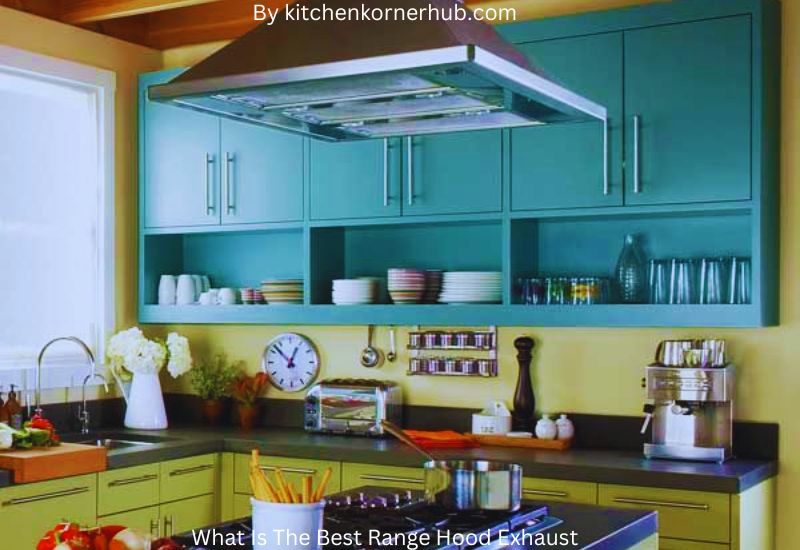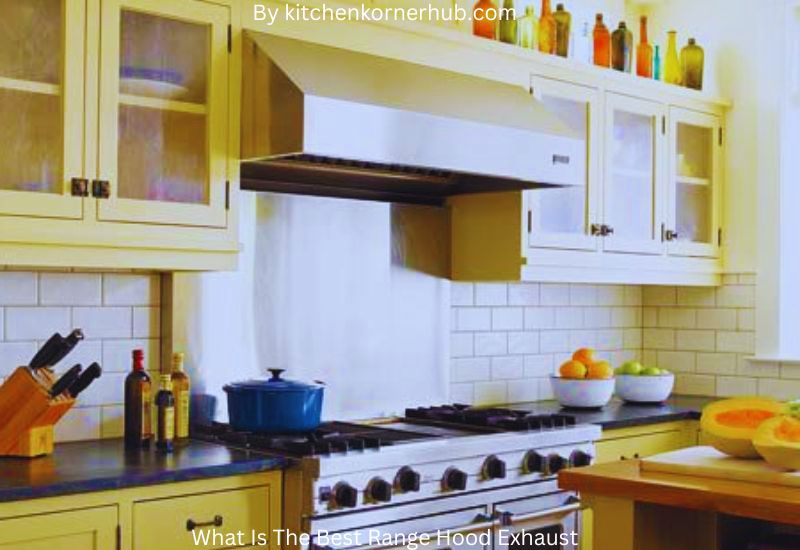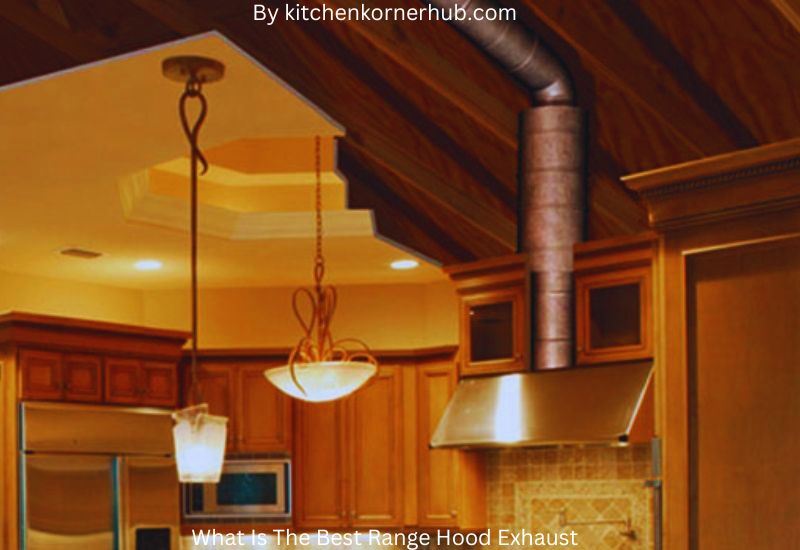When it comes to creating a comfortable and clean cooking environment in your kitchen, a range hood exhaust plays a vital role. A range hood exhaust, also known as a vent hood or extractor hood, is a crucial appliance that helps eliminate smoke, odors, grease, and airborne particles produced during cooking. It’s like having your own kitchen superhero that ensures your home remains free from unwanted smells and pollutants.
What Is The Best Range Hood Exhaust? The best range hood exhaust effectively removes cooking odors, steam, and grease while being quiet and efficient. It should match the stove’s size, provide adequate airflow, and have easy-to-clean filters. LED lighting and variable fan speeds are desirable features for optimal performance.
Choosing the best range hood exhaust for your kitchen involves considering various factors such as the size of your cooking area, the type of cooking you do, and the ventilation options available. A well-designed range hood exhaust not only enhances the air quality in your kitchen but also prevents the accumulation of grime on surfaces, thus reducing the need for frequent cleaning. With a plethora of options available on the market, finding the perfect range hood exhaust might seem overwhelming. This guide aims to simplify the process by highlighting key features and considerations, helping you make an informed decision to ensure a fresh and pleasant cooking experience.
Importance of an Effective Range Hood Exhaust System

In modern kitchens, the range hood exhaust system has become an indispensable appliance for maintaining a healthy and efficient cooking environment. With the increasing popularity of open-concept kitchens and diverse cooking styles, the significance of a well-functioning range hood exhaust system cannot be overstated.
This article explores the multifaceted importance of such a system, highlighting its benefits across several key aspects.
Air Quality Improvement:
One of the primary functions of a range hood exhaust system is to eliminate airborne pollutants, such as grease, smoke, steam, and odors, generated during cooking. These contaminants not only compromise the indoor air quality but can also lead to the accumulation of sticky residue on kitchen surfaces and appliances.
An effective exhaust system swiftly captures and expels these pollutants, preventing them from spreading throughout the house and ensuring a fresher, healthier breathing environment.
Fire Hazard Reduction:
Cooking activities involve the use of open flames and high temperatures, which can occasionally lead to grease fires. An efficient range hood with proper ventilation can help mitigate this risk by swiftly removing grease particles from the air before they settle on surfaces, reducing the potential for ignition. In the event of a small flare-up, the hood can aid in preventing the fire from escalating by quickly removing the heat and fumes.
Heat Regulation:
Cooking can generate substantial heat, causing discomfort in the kitchen and increasing the load on cooling systems. An effective range hood exhaust system aids in heat regulation by removing excess heat and steam from the cooking area, contributing to a more comfortable cooking experience.
This is particularly beneficial during hot weather or when preparing multiple dishes simultaneously.
Maintenance of Kitchen Surfaces:
The airborne particles produced during cooking, if left unchecked, can settle on kitchen surfaces, cabinets, and appliances, leading to a sticky and difficult-to-clean buildup. Over time, this buildup can tarnish the appearance of the kitchen and require intensive cleaning efforts.
A robust exhaust system minimizes the accumulation of such particles, thus reducing the frequency and intensity of cleaning required to keep the kitchen looking pristine.
. Prevention of Moisture Damage:
Steam generated during cooking can result in excess moisture accumulation in the kitchen, which may contribute to mold growth and potential water damage to walls and cabinets.
A high-quality range hood exhaust system effectively expels steam, preventing the formation of moisture-related issues and safeguarding the structural integrity of the kitchen space.
Factors to Consider When Choosing a Range Hood Exhaust

A range hood exhaust is an essential component in any kitchen, helping to maintain air quality and remove cooking odors, smoke, and grease. When selecting the right range hood exhaust for your kitchen, several crucial factors come into play to ensure optimal functionality and efficiency.
Ventilation Type:
One of the first decisions to make is the type of ventilation system suitable for your kitchen layout. There are two primary options: ducted and ductless. Ducted systems vent air outside through a duct, effectively removing pollutants from your home. Ductless systems use filters to recirculate air back into the kitchen after capturing particles. Consider the feasibility of duct installation and your kitchen’s specific needs when deciding on the ventilation type.
Exhaust Power and Size:
The exhaust power of a range hood is measured in cubic feet per minute (CFM). It’s essential to choose a range hood with adequate CFM to handle the size of your stove and the cooking demands in your kitchen.
As a general rule, a higher CFM rating is recommended for larger kitchens and gas stoves, while electric stoves may require less powerful exhaust systems. Select a hood size that matches your stove’s dimensions for efficient coverage.
Noise Levels:
The noise produced by a range hood can significantly impact your cooking experience. Consider the decibel (dB) level of the exhaust fan on various settings, especially if you have an open-concept kitchen where noise travels easily.
Look for range hoods with noise-reduction features or variable fan speeds to strike a balance between efficient ventilation and minimal noise.
Style and Design:
Range hoods come in a variety of styles and designs, ranging from sleek and modern to classic and ornate.
Choose a design that complements your kitchen’s overall aesthetics and blends seamlessly with other appliances and cabinetry. Wall-mounted, under-cabinet, island, and downdraft are common installation styles, each offering a unique visual appeal and practicality.
Maintenance and Filters:
Regular maintenance is crucial to the performance of your range hood exhaust. Consider the type of filters the system uses – metal baffle filters, charcoal filters, or mesh filters – and their ease of cleaning or replacement. Metal baffle filters are efficient and reusable with regular cleaning, while charcoal filters may need replacement every few months for optimal odor removal.
Comparing Different Types of Range Hood Exhausts

Range hood exhausts play a crucial role in maintaining indoor air quality and managing cooking odors, grease, and smoke. Choosing the right type of range hood exhaust is essential for effective ventilation in your kitchen. This article explores and compares various types of range hood exhausts to help you make an informed decision for your kitchen.
Ducted Exhaust Systems:
Ducted exhaust systems, also known as vented or external exhausts, are widely considered the most efficient option for kitchen ventilation. These systems channel pollutants and odors out of the kitchen through a series of ducts that lead to the exterior of the building.
By venting the air outdoors, ducted exhausts effectively remove grease, heat, steam, and cooking odors, ensuring that your kitchen and home remain free from lingering smells and potential health hazards. However, installation can be more complex and expensive compared to other options.
Ductless (Recirculating) Exhaust Systems:
Ductless exhaust systems, also called recirculating systems, filter the air through a set of filters and then release it back into the kitchen. While these systems are easier and less expensive to install compared to ducted systems, they are generally less effective in removing cooking odors and pollutants.
The filters need periodic replacement or cleaning to maintain their efficiency. Ductless systems can be suitable for kitchens where installing ductwork is challenging or not possible.
Convertible Exhaust Systems:
Convertible exhaust systems offer a compromise between ducted and ductless systems. They can be configured to operate as either ducted or ductless, providing flexibility for different kitchen setups.
This type of range hood is equipped with removable filters and a reversible motor. While it provides an adaptable solution, convertible exhausts might not be as efficient as dedicated systems in either configuration.
. Under-Cabinet Exhaust Hoods:
Under-cabinet range hoods are installed beneath kitchen cabinets and are suitable for kitchens with limited space. These hoods can come in both ducted and ductless configurations. They are popular for their space-saving design and ease of installation.
However, under-cabinet hoods may have slightly reduced performance compared to larger, more specialized options.
Wall-Mounted and Island Exhaust Hoods: Wall-mounted and island range hoods are typically larger and more powerful options, suitable for spacious kitchens and cooking areas. Wall-mounted hoods are affixed to the wall, while island hoods are suspended from the ceiling above a cooking island. These hoods are available in both ducted and ductless versions. They are known for their high ventilation capacity and impressive visual presence, making them a focal point of the kitchen design.
Ducted vs. Ductless: Pros and Cons of Range Hood Ventilation

Range hood ventilation is an essential aspect of any kitchen, as it aids in maintaining indoor air quality and preventing the buildup of cooking odors, grease, and airborne particles. When considering the most suitable ventilation system for your kitchen, two primary options emerge: ducted and ductless range hoods.
Each option comes with its own set of advantages and disadvantages, catering to various kitchen setups and preferences.
Ducted Range Hoods: Efficient and Effective
Ducted range hoods, also known as vented or exhaust hoods, are connected to an external ventilation system that expels the cooking byproducts outdoors. One of the major advantages of ducted range hoods is their efficiency in removing smoke, grease, and odors from the kitchen.
By venting outside, these hoods ensure that pollutants are effectively eliminated, maintaining a fresher indoor environment. Additionally, ducted hoods tend to have higher suction power, making them more capable of handling heavy cooking tasks like frying and grilling.
Pros:
- Effective Air Filtration: Ducted hoods excel in filtering out and expelling cooking pollutants, ensuring improved air quality.
- Stronger Performance: With greater suction power, they are better equipped to handle intense cooking processes.
- Minimal Maintenance: As airborne particles are vented outside, there’s less likelihood of grease buildup within the kitchen.
Cons:
- Installation Complexity: Setting up a ducted system can be more complicated and expensive, often requiring professional assistance.
- Space and Design Limitations: Ductwork might necessitate additional space and alter the kitchen’s aesthetic.
Ductless Range Hoods: Flexible and Simple
Ductless range hoods, also called recirculating hoods, do not expel air outdoors; instead, they employ filters to capture and purify airborne particles before recirculating the cleaned air back into the kitchen.
These hoods are ideal for kitchens where duct installation is impractical or costly. Ductless hoods offer more flexibility in terms of placement, as they aren’t constrained by the need for external ventilation.
Pros:
- Ease of Installation: Ductless hoods are generally simpler to install, as they don’t require ductwork and modifications to the building structure.
- Cost-Effective: The absence of ductwork reduces installation expenses, making them a budget-friendly option.
- Location Flexibility: Ductless hoods can be placed anywhere, offering design versatility within the kitchen.
Cons:
- Limited Efficiency: While they can remove some odors and particles, ductless hoods are less effective at eliminating heavy smoke and grease.
- Filter Replacement: Filters need regular cleaning or replacement to maintain performance, adding to maintenance efforts.
- Air Circulation Only: Ductless systems recirculate air, which means pollutants aren’t completely expelled from the kitchen.
Choosing the Right Fit The decision between ducted and ductless range hoods depends on factors like kitchen layout, cooking habits, and budget. For those who frequently engage in high-heat cooking methods, such as grilling or frying, a ducted system’s superior performance is advantageous.
However, if duct installation is problematic or cost-prohibitive, or if the kitchen layout demands flexibility, a ductless system can offer a practical solution. Balancing efficiency, installation ease, and aesthetic considerations will guide you toward the ventilation system that best suits your kitchen and lifestyle.
Noise Levels and Performance: Finding the Balance

In the modern world, noise has become an unavoidable part of our daily lives, whether it’s the bustling traffic on city streets, the constant hum of electronic devices, or the chatter in crowded spaces. While it might seem like a minor inconvenience, noise levels can have a significant impact on our performance, both in professional and personal spheres. Striking the right balance between noise levels and optimal performance is a challenge that requires understanding the intricate relationship between noise and cognitive functions.
The Cognitive Impact of Noise:
Noise doesn’t just affect our auditory sense; it can profoundly influence our cognitive abilities. Studies have shown that excessive noise can lead to reduced concentration, impaired memory, and decreased problem-solving skills.
This is because the brain’s ability to process information efficiently is hindered when it’s constantly exposed to background noise. Our brains are wired to filter out irrelevant stimuli, but when noise becomes too intrusive, it disrupts this process, leading to decreased cognitive performance.
The Yerkes-Dodson Law in Noise Performance:
The Yerkes-Dodson Law, a principle in psychology, states that there’s an optimal level of arousal for peak performance. This law applies to noise as well – a certain level of noise can enhance performance by boosting alertness and motivation.
However, beyond this optimal point, additional noise becomes detrimental, causing stress and hindering focus. Finding the sweet spot where noise enhances rather than impairs performance is crucial for various contexts, such as workplaces, classrooms, and public spaces.
Noise in Different Environments:
Understanding the impact of noise on performance requires considering the specific environment. For example, in open office settings, the constant hum of conversations and office equipment can lead to reduced productivity and increased stress.
On the other hand, in creative spaces like design studios, a moderate level of background noise might stimulate innovative thinking. Similarly, in educational settings, noise levels should be managed to ensure effective learning without overwhelming students.
Strategies for Managing Noise:
Balancing noise levels and performance involves implementing effective strategies. Noise-cancelling technologies can be a boon in noisy environments by reducing external distractions.
Designing spaces with acoustic considerations in mind, such as sound-absorbing materials and layout optimization, can significantly mitigate noise-related issues. Additionally, introducing designated quiet zones or break areas can give individuals the chance to recharge away from excessive noise.
Personal Variability and Adaptation:
It’s important to note that individuals have varying levels of tolerance to noise, and what works for one person may not work for another. Some individuals thrive in high-energy, noisy environments, while others require near-silence to concentrate.
Adapting strategies to accommodate these individual differences, along with promoting awareness about the potential impacts of noise, can contribute to a more harmonious and productive coexistence.
Conclusion
In conclusion, determining the best range hood exhaust involves a careful consideration of various factors, including kitchen size, cooking habits, ventilation needs, and budget constraints. While ducted systems excel in effectively removing odors and pollutants, ductless systems offer flexibility in installation. The ideal choice hinges on striking a balance between efficiency and convenience. Ultimately, a personalized approach is key, ensuring that the chosen range hood exhaust aligns seamlessly with i
Frequently Asked Question(What Is The Best Range Hood Exhaust)
What is the best vent pipe for a range hood?
When considering the ideal vent pipe for a range hood, it’s important to prioritize efficiency and proper ventilation. Generally, rigid metal ducts, such as those made of stainless steel or galvanized steel, are recommended due to their durability and ability to withstand heat and grease over time.
These ducts facilitate better airflow, reducing the risk of blockages and promoting effective extraction of cooking fumes and odors.
What is the most powerful kind of range hood?
Among the various types of range hoods, a canopy-style or island range hood tends to be the most powerful. These hoods typically feature higher extraction rates and larger capture areas, which enable them to effectively handle the increased volume of cooking fumes produced by larger cooktops or ranges.
With greater suction power and coverage, canopy-style range hoods are ideal for kitchens where heavy-duty cooking takes place regularly.
What is the best range hood to remove smell?
When seeking a range hood specifically designed to eliminate cooking smells, a model with a strong ventilation capacity and effective filtration system is key. Look for range hoods equipped with a combination of a high-quality charcoal or activated carbon filter and a powerful exhaust fan.
These filters are specifically designed to trap and neutralize odors, ensuring that your kitchen remains free from lingering cooking smells.
How do I choose an exhaust hood?
Selecting the right exhaust hood involves considering several factors. Begin by assessing the size of your cooktop or range, as this will determine the required ventilation capacity. Next, consider the layout of your kitchen – wall-mounted hoods are suitable for against-the-wall cooktops, while island hoods are ideal for cooktops located on islands.
Evaluate the hood’s noise level, energy efficiency, and ease of maintenance. Additionally, opt for a hood with variable fan speeds to accommodate different cooking scenarios. It’s also essential to choose a hood that complements your kitchen’s aesthetics, whether it’s a sleek stainless steel design or a more decorative option.




